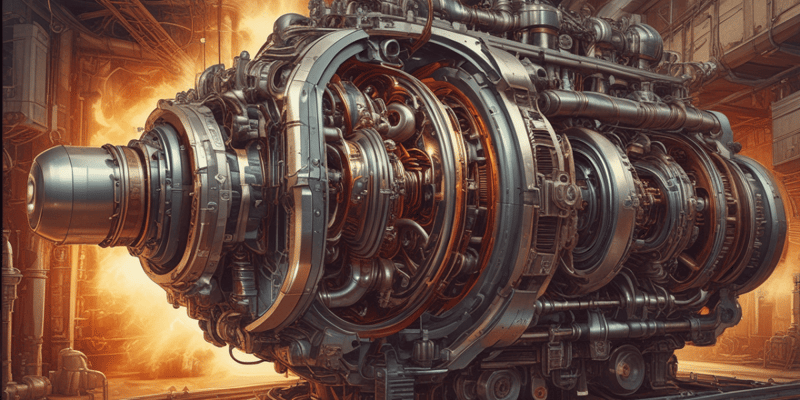Podcast
Questions and Answers
What is the primary function of a heat engine?
Heat pumps are designed to convert heat into work.
False
What do you understand by the term 'combustion'?
Combustion is the process of burning fuel in the presence of an oxidant, resulting in products and heat.
In the Arrhenius rate expression, the term $E_a$ represents __________.
Signup and view all the answers
Match the following concepts with their descriptions:
Signup and view all the answers
According to the Arrhenius rate expression, what happens to the reaction rate as temperature increases?
Signup and view all the answers
What role does the rate constant $k(T)$ play in chemical reactions?
Signup and view all the answers
In a first-order chemical reaction, the decay of reactants is independent of their concentration.
Signup and view all the answers
Study Notes
Heat Engines and Heat Pumps
- Heat Engines convert heat into work
- Heat Pumps convert work into heat
Carnot Cycle
- Not covered in the text.
Chemical Rate Processes
- The release of heat through burning (combustion)
- Fuel + Oxidant = Products + Heat
-
Rate of Fuel Burning is governed by: k(T) = k0 exp (-Ea/RT)
- k(T) is the rate constant
- k0 relates to molecular collision frequency
- Ea is the difference in energy between reacting molecules and the average energy of all molecules
- Rate of Reaction Increases Exponentially with Temperature
- Quantifying Heat Release is denoted as 𝑄ሶ
-
Arrhenius Rate Expression: k(T) = k0 exp (-Ea/RT)
- k(T): the rate constant, representing the reaction velocity.
- k0: a pre-exponential factor related to the frequency of collisions between reacting molecules.
- Ea: the activation energy, representing the energy required for molecules to overcome the energy barrier and react.
- R: the ideal gas constant.
- T: the absolute temperature.
Nuclear Rate Processes:
- Conversion: Species transform into others, releasing heat during the process.
-
Simple First-Order Reaction: A → B
- Rate of Disappearance of A ( 𝑚ሶ 𝐴): -d[A]/dt = k[A], with a = 1 and b = 0 (slide 5).
- Solving the Equation: Requires an initial condition, typically the concentration of A at time t = 0: [A(t = 0)]
Studying That Suits You
Use AI to generate personalized quizzes and flashcards to suit your learning preferences.
Related Documents
Description
Test your knowledge on heat engines, heat pumps, and chemical rate processes. Explore concepts like the Carnot cycle, Arrhenius rate expression, and the impact of temperature on reaction rates. Enhance your understanding of how heat is converted to work and the principles governing combustion.




